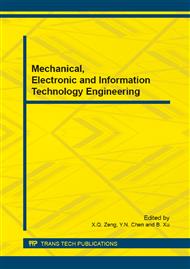[1]
M. Z. Win and R. A. Scholtz, Ultra-wide band-width time-hopping spread-spectrum impulse radio for wireless multiple-access communications, IEEE Trans. Commun., vol. 48, no. 4, pp.679-690, (2000).
DOI: 10.1109/26.843135
Google Scholar
[2]
M. Miao and C. Nguyen, On the development of an integrated CMOS-based UWB tunable-pulse transmit module, IEEE Trans. Microw. Theory Techn., vol. 54, no. 10, pp.3681-3687, (2006).
DOI: 10.1109/tmtt.2006.882874
Google Scholar
[3]
A. Nasri, R. Schober and L. Lampe, Performance of BICM-OFDM systems in UWB interference, IEEE Trans. Wireless Commun., vol. 8, no. 9, pp.4389-4392, (2009).
DOI: 10.1109/twc.2009.071125
Google Scholar
[4]
C. J. Le Martret and G. B. Giannakis, All-digital PAM impulse radio for multiple-access through frequency-selective multipath, In Proc. IEEE GLOBELCOM 2000, vol. 1, San Francisco, pp.77-81, (2000).
DOI: 10.1109/glocom.2000.891694
Google Scholar
[5]
S. Villarreal-Reyes and R.M. Edwards, Analysis techniques for the power spectral density estimation of convolutionally coded impulse radio UWB signals subject to attenuation and timing jitter, IEEE Trans. Veh. Technol., vol. 58 , no. 3, pp.1355-1374, (2009).
DOI: 10.1109/tvt.2008.926619
Google Scholar
[6]
A.M. Pistea, H.S. Rad, Wideband and ultra-wideband characterization of three-dimensional MIMO wireless channels, IEEE Commun. Lett., vol. 16, no. 2, pp.205-207, (2012).
DOI: 10.1109/lcomm.2011.112311.111948
Google Scholar
[7]
S. L. Pan and J. P. Yao, Performance evaluation of UWB signal transmission over optical fiber, IEEE J. Sel. Areas Commun., vol. 28 , no. 6, pp.889-900, (2010).
DOI: 10.1109/jsac.2010.100813
Google Scholar
[8]
M. Sushchick Jr., N. Rulkov, L. Tsimring, H. Abarbanel, K. Yao and A. Volkovskii, Chaotic pulse position modulation: A robust method of communicating with chaos, IEEE Commun. Lett., vol. 4, no. 4, pp.128-130, Apr., (2000).
DOI: 10.1109/4234.841319
Google Scholar
[9]
G.M. Maggio, N. Rulkov and L. reggiani, Pseudo-chaotic time hopping for UWB impulse radio, IEEE Trans. Circuits Syst. I, Reg. Papers, pp.1424-1435, Dec., (2001).
DOI: 10.1109/tcsi.2001.972849
Google Scholar
[10]
R. A. Scholtz, P. Vijay Kumar and Carlos Corrada Bravo, Some problems and results in ultra-wideband signal design, " In Proc. SETA, 01, May, (2001).
Google Scholar
[11]
M.S. Iacobucci and M. G. Di Benedetto, Multiple access design for impulse radio communication systems, in Proc. IEEE ICC 2002, pp.817-820, (2002).
DOI: 10.1109/icc.2002.996969
Google Scholar
[12]
V.S. Somayazulu, Multiple access performance in UWB systems using time hopping vs. direct sequence spreading, in Proc. IEEE Wireless Communications and Networking Conference, vol. 2, pp.522-525, (2002).
DOI: 10.1109/wcnc.2002.993322
Google Scholar
[13]
Z. Y. Zhang, F. X. Zeng and L. J. Ge, Correlation properties of time-hopping sequences for impulse radio, in Proc. IEEE International Conference on Acoustics, Speech and Signal Processing, Hong Kong, China, pp.141-144, Apr., (2003).
DOI: 10.1109/icassp.2003.1202570
Google Scholar
[14]
C. Y. Han and G. Y. Wang, A novel multi-address chaotic sequence for TH-PPM-UWB system, in Proc. 2010 International Conference on Communications, Circuits and Systems, pp.764-768, (2010).
DOI: 10.1109/icccas.2010.5581880
Google Scholar
[15]
H. Shao and N.C. Beaulieu, Direct sequence and time-hopping Sequence designs for narrowband interference mitigation in impulse radio UWB systems, IEEE Trans. Commun., vol. 59, no. 7, pp.1957-1965, (2011).
DOI: 10.1109/tcomm.2011.060911.100581
Google Scholar
[16]
Z. Y. Zhang, F. X. Zeng and L. J. Ge, Theoretical bounds on time-hopping sequences for ultra wideband, in Proc. IEEE 61st Semiannual Vehicular Technology Conference, Stockholm, Sweden, pp.2003-2007, (2005).
DOI: 10.1109/vetecs.2005.1543674
Google Scholar
[17]
M.A. Khan, Comparison of TH-SS and DS-SS with sleeping protocol for LDR-UWB network, in Proc. 2012 7th International Conference on Electrical & Computer Engineering, pp.280-282, (2012).
DOI: 10.1109/icece.2012.6471540
Google Scholar
[18]
N. Suehiro, Elimination filter for co-channel interference in asynchronous SSMA systems using ployphase modulatable orthogonal sequences, IEICE Trans. Commun., vol. E75-B, (1992).
DOI: 10.1109/icsyse.1992.236928
Google Scholar


